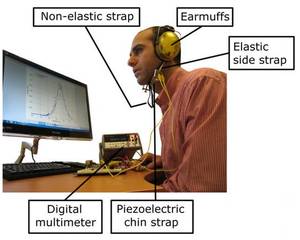Using a 'smart' piezoelectric material chin strap we have the potential to power our electric devices when we chew and chat, according to research published last week in the Institute of Physics journal Smart Materials and Structures.
our electric devices when we chew and chat, according to research published last week in the Institute of Physics journal Smart Materials and Structures.
Scientists Dr Aidin Delnavaz and Professor Jérémie Voix from the École de Technologie Supérieure in Montreal, Canada, have created a chin strap device embedded with piezoelectric fibre composites, known as PFC, which turn jaw movements into energy.
Placing a mechanical stress on piezoelectric material creates an electrical current, which can then be harnessed and used productively. This material is commonly found in BBQ lighters that use the 'piezoelectric effect' to create a spark.
Energy is certainly a hot topic at the moment, with an ever-increasing need to reduce our carbon footprint and turn to more environmentally friendly options. Generating energy from our own body movements appears to be an interesting and renewable way of harvesting energy for our headsets, hearing aids and other electronic devices.
Just from moving the jaw - through chewing gum, munching food or chatting away - electricity is generated and used to reduce our dependence on batteries, which are not only expensive, but also damaging to the environment.
A prototype device was built using PFC and a pair of earmuffs, and then later tested on study participants and researcher Dr Delnavas himself. After chewing on gum whilst wearing this chin strap for 60 seconds, energy was produced at an average rate of 7 microwatts (mW).
This tiny amount of energy is vastly insufficient to power our 'energy-gobbling' modern electronics. However, whilst these numbers are hardly likely to solve the energy crisis anytime soon, it still shows the potential of both this material and our mouths as an energy source.
"This is really a proof of concept," commented Professor Voix, indicating that this is the first step in a long line of future developments.
These include using layered bundles of PFC, which could help to create far larger outputs of power, adequate to charge devices. Alternatively, the researchers are considering introducing a rechargeable battery that could be integrated into the chin strap and used to store electricity which builds up over time.
But realistically, who would want to wear this not so stylish looking contraption? I cannot imagine the youth of today walking around town with a pair of earmuffs and a chin strap on their head, no matter how desperate they are to keep their iPhone charged up.
Professor Voix admitted that the device may not be as appealing for commercial buyers, but may attract avid skiers or snowboarders who would like to simultaneously listen and power their music player at the same time whilst out on the slopes.
For emergency services workers, such as firemen and police, the military and also construction workers that are required to wear helmets and headsets, the benefits are obvious.
But why stop at chin straps? Perhaps we could incorporate PFC into our trousers or shirts, so we could make energy when bending over or stretching our arms for instance.
Listen to the interview here:
- Previous New solar cell powers hydrogen economy
- Next New MS treatment










Comments
Add a comment